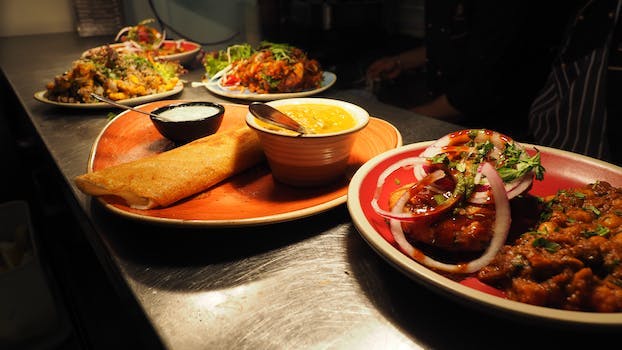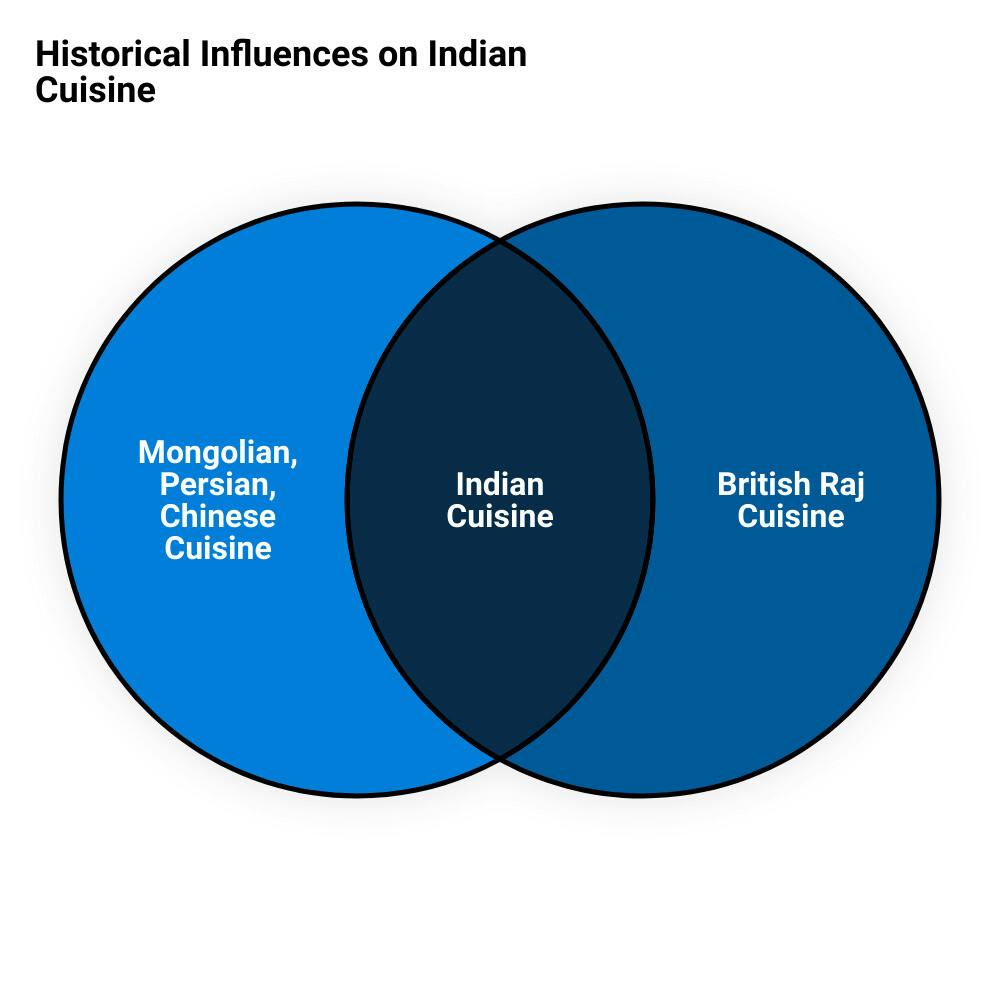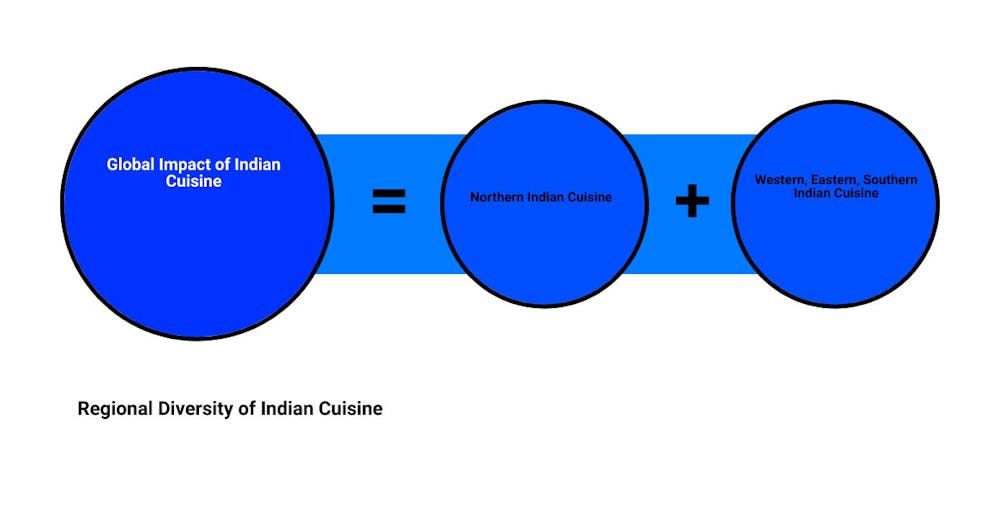Discovering the Fusion of Indian Food with Global Influences
Discovering the Fusion of Indian Food with Global Influences

Introduction: The Global Influence on Indian Cuisine
Embracing the vibrant tapestry of global flavors, Indian cuisine offers an exciting gastronomic journey that transcends borders. This unique culinary landscape is not just born out of the country's rich cultural history and diverse regional flavors, but also its significant interactions with foreign cuisines. The global influence on Indian cuisine is a fascinating study, tracing the footprints of foreign conquerors, traders, and settlers who have left an indelible mark on the subcontinent's food culture.
Historically, Indian cuisine has been shaped by Mongolian, Persian, and Chinese influences, among others. It has also been molded by the religious and cultural practices of Hinduism, Buddhism, Jainism, and Sikhism. The British Raj period further introduced new culinary practices and dishes to the Indian table.
Today, this fusion of flavors continues to evolve, with Indian dishes gaining popularity worldwide and foreign dishes being enthusiastically adopted and adapted in India. This global culinary exchange has not only diversified Indian food but also underscored its universal appeal.
In this article, we'll explore how global influences have shaped Indian cuisine, from historical times to the present day. We'll delve into the regional diversity of Indian food, the global popularity of Indian dishes, and how Indian street food at Desi Contemporary Indian Casual & Gabru Bar continue to celebrate this global fusion. So, let's begin our exploration of the delightful dance between Indian food and global influences.

The Historical Influence of Foreign Conquerors on Indian Cuisine
The journey of Indian cuisine is a narrative that brims with the tales of foreign invasions and the culinary influences they brought. Each conqueror introduced new elements, enhancing the richness of Indian cuisine and blending it subtly with their own food traditions.
The Impact of Mongolian, Persian, and Chinese Cuisine on Indian Food
Mongolian, Persian, and Chinese influences have left indelible marks on Indian food. The Mongols, known for their meat-centric cuisine, introduced the concept of marinating meats in spices and cooking them over open fires. This technique evolved into the famous Tandoori cooking method, a signature of Indian cuisine.
The Persian influence, on the other hand, is evident in the rich and aromatic biryanis and pulaos, known for their delicately spiced rice and meat combinations. The Persian culture of feasting and emphasis on presentation also heavily influenced Indian culinary practices.
Chinese cuisine has also significantly impacted Indian food. The Indo-Chinese fusion dishes, like chili paneer and hakka noodles, are beloved across the country. These dishes beautifully meld Indian spices with Chinese flavors, manifesting the harmonious blend of these two culinary traditions.
The Influence of British Raj on Indian Cuisine
The British rule brought about substantial changes in Indian cuisine, leading to the birth of Anglo-Indian cuisine. The British penchant for milder flavors led to the creation of dishes like curry, chutney, kedgeree, mulligatawny and pish pash, which were palatable to English taste buds.
Curry, an essential part of Indian cuisine, was toned down and modified to suit the British palate, resulting in dishes like chicken tikka masala, now popularly considered a British national dish. Even today, the influence of British Raj can be tasted in the Anglo-Indian dishes that have become an integral part of Indian cuisine.
The historical influences on Indian cuisine are a testament to its adaptability and versatility. These foreign conquerors not only shaped India's history but also profoundly impacted its food culture, making Indian cuisine the diverse and flavorful culinary treasure it is today.
The Cultural and Religious Influences on Indian Cooking
A potent blend of history, culture, and religion, Indian cuisine is a vibrant reflection of the country's diverse heritage. Drawing from a rich tapestry of traditions and beliefs, Indian food is not just about the unique combination of spices and flavors – it's a culinary narrative deeply intertwined with the country's religious and cultural ethos.
The Role of Hinduism, Buddhism, Jainism, and Sikhism in Shaping Indian Cuisine
From the sattvic diet of Hinduism to the vegetarianism of Jainism, India's major religions have significantly influenced its cuisine. The culinary practices of Hindus, Buddhists, Jains, and Sikhs have each contributed to the uniqueness and diversity of Indian food.
Hinduism, with its emphasis on non-violence and respect for all life forms, encourages a vegetarian diet, which is why many Indian dishes are plant-based. On the other hand, Buddhism's influence on Indian cuisine is seen in the simple, minimalistic preparation methods, focusing on preserving the natural flavors of the ingredients.
Jainism, with its strict adherence to non-violence, has led to a diet free from root vegetables and certain other foods. This religious influence has resulted in a distinct culinary tradition within Indian cuisine, characterized by the avoidance of onions, garlic, and even certain types of green leafy vegetables.
Sikhism, a religion known for its community kitchens or 'Langars', has also shaped Indian food with its emphasis on communal eating and sharing. Sikh cuisine, rich in hearty, wholesome dishes, reflects the community's spirit of togetherness and generosity.
The Impact of Dietary Restrictions and Vegetarianism on Indian Food
The dietary restrictions imposed by different religions have played a vital role in shaping the diversity of Indian cuisine. The abundance of vegetarian dishes in Indian cuisine is a testament to the influence of Hinduism, Buddhism, and Jainism, which advocate for a plant-based diet.
Indian vegetarian cuisine is a rich assortment of dishes made from legumes, grains, fruits, and vegetables. From lentil-based dishes like 'dal' to vegetable curries and rice dishes, vegetarianism has given rise to an array of unique and flavorful meals. Even within vegetarianism, there are variations. For instance, the Jain practice of avoiding root vegetables has led to innovative culinary practices and recipes.
Indian cuisine is also known for its dairy-based dishes and desserts, a result of the acceptance of dairy products in vegetarian diets. From creamy curries to sweet dishes like 'rasgulla' and 'kulfi', dairy is an integral part of Indian cuisine.
In conclusion, the cultural and religious influences on Indian cooking have shaped a cuisine that is as diverse and complex as the country itself. From the dietary practices dictated by religion to the regional variations influenced by culture, Indian cuisine is a flavorful journey through the country's rich heritage. This culinary diversity ensures that whether you're a vegetarian or a meat-lover, there's an Indian dish to tantalize your taste buds.
The Global Popularity of Indian Cuisine
As we venture further into the intricate world of Indian food, it's impossible to overlook the remarkable global popularity it enjoys. The rich flavors, complex spice blends, and diverse range of dishes have captured the hearts of food enthusiasts worldwide. This section explores the love for Chinese cuisine in India and the emergence and global acceptance of Anglo-Indian cuisine.
The Love for Chinese Cuisine in India
In the global culinary scene, Chinese cuisine holds a special place, and India is no exception. With 77% of Indians having a fondness for Chinese cuisine, it's evident that this foreign cuisine has made a lasting impact. However, India's love affair with Chinese food isn't restricted to traditional dishes alone. The country has crafted its own unique spin on Chinese cuisine, resulting in the popular Indo-Chinese fusion food. This fusion cuisine harmoniously blends the fiery spices of India with the subtle flavors of Chinese food, creating dishes like chili paneer and hakka noodles that have now become an integral part of India's culinary landscape.
The Emergence of Anglo-Indian Cuisine and its Global Acceptance
The British Raj left an indelible mark on India's history, including its cuisine. Anglo-Indian cuisine, which developed during this period, introduced India to dishes like curry, chutney, kedgeree, mulligatawny, and pish pash.
In a delightful twist of fate, this fusion cuisine didn't just influence Indian palates but also made its way back to Britain. Today, British national dishes like chicken tikka masala, which originated in India, serve as a testament to the global influence of Indian cuisine.
Anglo-Indian cuisine's popularity isn't constrained to the UK alone. It has found favor in various parts of the world, including North America and South Africa, where Indian techniques, ingredients, and flavors have been embraced and integrated into local cuisines.
The global popularity of Indian cuisine, coupled with its ability to fuse with other culinary traditions, underscores not only its versatility but also its universal appeal. As we move forward, we'll delve deeper into specific Indian dishes that have been influenced by global cuisines, further highlighting the fascinating fusion of Indian food with global influences.
Indian Dishes with Global Influences
The gastronomic world is a melting pot of flavours, techniques, and traditions. Nowhere is this more apparent than in the way Indian dishes have traversed borders, melding with global cuisines to create distinct culinary delights.
The Journey of Khichuri from India to Britain and Egypt
The humble khichuri, a comforting dish of rice, lentils, and vegetables, travelled from the Indian subcontinent to Britain, transforming into the kedgeree, a mix of rice, flaked fish, and boiled eggs. This dish was invented for the British in India and was served at country houses or parties. The British loved the Indian concept of garnishes, adding a breakfast staple - boiled eggs - as a finishing touch to the kedgeree.
The Evolution of Indian Dishes like Rasam and Litti Choka in British and Caribbean Cuisine
Indian food has not only influenced British cuisine but has also found its way into the Caribbean kitchen. Dishes like Rasam, a South Indian soup, inspired the creation of dishes like Mulligatawny soup, a favourite in British and Caribbean households. Similarly, Litti Choka, a popular dish from Bihar in eastern India, shares striking similarities with the Caribbean dish, Doubles. Both are street foods involving filled bread; Litti is stuffed with sattu (roasted chickpea flour) and served with choka (roasted vegetable mash), while Doubles is a sandwich of curry chickpeas between two pieces of fried bread.
The Influence of Indian Cuisine on French and Portuguese Dishes
Equally intriguing is how Indian cuisine has influenced French and Portuguese dishes. Goa, a former Portuguese colony, has a unique culinary scene where traditional Indian spices are blended with Portuguese flavours. This fusion resulted in dishes like Vindaloo, originally a Portuguese dish, that was adapted to the Goan palate by adding local ingredients like palm vinegar and Kashmiri chillies.
On the other hand, the French reinterpretation of Indian cuisine is evident in dishes like Poulet à l’Indienne, a chicken dish cooked in a creamy sauce infused with Indian spices. This dish is a testament to the French love for rich, flavourful sauces and their fascination with Indian spices.
Indian cuisine's influence on global food is a testament to the versatility, adaptability, and universal appeal of its flavours and techniques. As we continue to explore the fusion of Indian food with global influences, we realise that food is not just about sustenance but also about sharing cultures, stories, and experiences.

The Regional Diversity of Indian Cuisine and its Global Impact
Indian cuisine is a mosaic of flavours, each piece telling a story of its region’s culture, geographical influences, and historical events. This great diversity in Indian cuisine has not only created a culinary repertoire of staggering variety but also influenced cuisines around the world.
The Unique Characteristics of Northern, Western, Eastern, and Southern Indian Cuisine
Starting in the North, the cuisine is heavily influenced by Mughals and Persians, resulting in rich, creamy dishes like biryanis and samosas. The West, with states like Gujarat and Maharashtra, is known for its sweet and tangy flavours, with a predominance of vegetarian dishes due to religious beliefs.
Heading east, the cuisine is marked by the use of mustard oil and a preference for fish, reflecting the region's abundant rivers and coastal geography. The South, with its hot and humid climate, has a cuisine that revolves around rice and lentils, with a generous use of coconut and tamarind.
This regional diversity is complemented by a range of cooking techniques, from tandoor grilling in the North to steaming in the South, each adding a unique dimension to Indian cuisine.
The Global Influence of Indian Spices and Ingredients
It's impossible to discuss Indian cuisine without mentioning its vast array of spices. Indian spice blends, or masalas, often incorporate five or more different spices, sometimes combining 10 or more. These include chili pepper, black mustard seed, cumin, turmeric, fenugreek, ginger, garlic, cardamom, cloves, coriander, cinnamon, nutmeg, saffron, and more.
The global impact of these spices and ingredients is undeniable. The spice trade between India and Europe sparked Europe’s Age of Discovery, with spices being bought in India and shipped throughout Europe and Asia. This has influenced other cuisines around the world, particularly those from Southeast Asia, the British Isles, and the Caribbean.
The global popularity of Indian dishes like chicken tikka masala, an original of India that's now considered the national dish of the United Kingdom, further underscores the influence of Indian spices and ingredients. Similarly, the use of spices such as onion, garlic, and various meat-cooking techniques from Indian cuisine have found their way into Italian, Mexican, South African, and American cuisines.
In conclusion, the regional diversity of Indian cuisine combined with its unique selection of spices and ingredients has not only shaped the face of Indian food but also left an indelible mark on global cuisine. As societies continue to become more interconnected, the fusion of Indian food with global influences is set to expand, creating more exciting culinary adventures for food enthusiasts around the world.
The Fusion of Indian Street Food with Global Cuisines at Desi Contemporary Indian Casual & Gabru Bar
As the world becomes more interconnected, the culinary landscape continues to evolve. At the forefront of this evolution is Desi Contemporary Indian Casual & Gabru Bar, a unique dining destination that effortlessly marries the traditional flavors of Indian street food with global influences.
The Adventurous and Delicious Dishes Celebrating the Similarities between Various Global Cuisines
Redefining boundaries and pushing culinary limits is a part of Desi's ethos. Their menu is a testament to the harmonious coexistence of diverse world flavors, where each dish is an exploration of taste and innovation. Desi team is passionate about breaking the mold and creating a unique dining experience that transcends cultural boundaries.
Taking inspiration from the vibrant streets of India, Desi's innovative street food offerings not only satisfy cravings for traditional Indian flavors but also introduce patrons to a whole new world of gustatory delights. They celebrate the similarities between world cuisines by fusing Indian street food with global elements. Dishes like their unique take on pakoras and their bold, flavor-packed curries bear testament to this culinary fusion.
The Craft Cocktail Program at Gabru Bar Inspired by Global Influences
The fusion of Indian food with global influences extends to the drinks menu at Gabru Bar. It's here that the art of mixology takes an adventurous turn. The bar's craft cocktails, inspired by global flavors, are a delightful surprise for both the eyes and the taste buds.
The cocktail program at Gabru Bar is all about reimagining the cocktail game. Their skilled mixologists experiment with unique ingredients and techniques to create concoctions that are a blend of tradition and innovation. Indian-inspired cocktails, with their blend of exotic spices and herbs, tropical fruits, and unique liqueurs, offer patrons a tantalizing journey through the world of spirits.
But what's a fantastic cocktail without the perfect food pairing? The team at Gabru works closely with Desi's culinary team to ensure each drink complements and enhances the flavors of their signature dishes. The fusion of bold spices, aromatic herbs, and fresh ingredients creates a symphony of flavors that elevate the entire dining experience.
In conclusion, the fusion of Indian street food with global influences at Desi Contemporary Indian Casual & Gabru Bar is a testament to the evolving culinary landscape. It's a celebration of the beautiful harmony that exists between different world flavors, and a reflection of the shared human experience of enjoying good food. So, next time you're in the mood for an adventurous culinary journey, head over to Desi and Gabru Bar. Cheers to the world of culinary diversity, one bite and sip at a time!
Conclusion: The Continuing Evolution of Indian Food with Global Influences
The journey of Indian cuisine through the ages is a testament to the power of gastronomic fusion, the magic that happens when diverse culinary traditions intersect and mingle. As we've explored, Indian cuisine has been shaped and enriched by various foreign influences, from the Mongols and Persians to the British. Equally, it has impacted and inspired cuisines across the globe, from Britain to the Caribbean, France to Egypt, and many more.
This fascinating interplay of flavors, ingredients, and cooking techniques is not a thing of the past. Indian cuisine continues to evolve and adapt, constantly reinventing itself in tune with global trends and tastes. The beauty of this evolution is that it doesn't dilute the essence of Indian food. On the contrary, it enhances and diversifies it, offering a fresh, modern take on traditional flavors.
At the forefront of this exciting gastronomic evolution is the fusion of Indian street food with global cuisines, exemplified by Desi Contemporary Indian Casual and Gabru Bar. The menu at Desi and Gabru Bar offers an adventurous and delicious exploration of global influences on Indian food, from Chinese to Mexican. The craft cocktail program at Gabru Bar, inspired by global trends, is another testament to the ever-evolving nature of Indian cuisine.
In essence, Indian cuisine is not just about the food; it's about the stories, the history, and the cultural tapestry that each dish represents. As diners, we're not just consuming a meal; we're partaking in a rich, centuries-old tradition of culinary artistry and innovation, a tradition that continues to evolve and inspire. So, as we celebrate the global influences on Indian food, let's also look forward to the new flavors, dishes, and culinary adventures that the future holds.
In the end, the continuous evolution of Indian food with global influences is a celebration of diversity, innovation, and shared culinary heritage. And at Desi Contemporary Indian Casual and Gabru Bar, we're thrilled to be part of this exciting, ever-evolving gastronomic journey.
